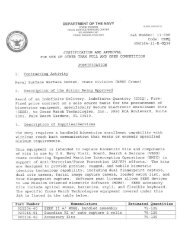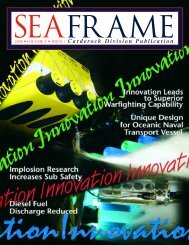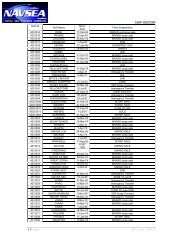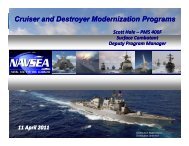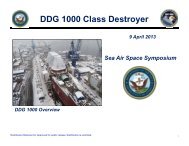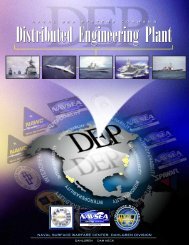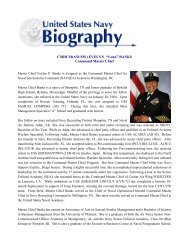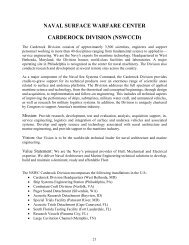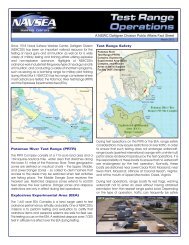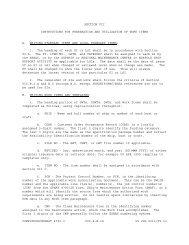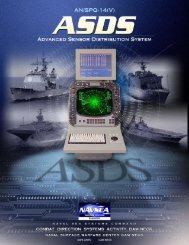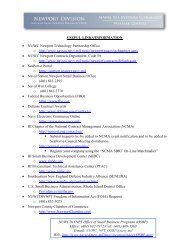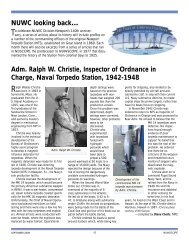Volume 6, Issue 1 - Naval Sea Systems Command - The US Navy
Volume 6, Issue 1 - Naval Sea Systems Command - The US Navy
Volume 6, Issue 1 - Naval Sea Systems Command - The US Navy
You also want an ePaper? Increase the reach of your titles
YUMPU automatically turns print PDFs into web optimized ePapers that Google loves.
SEAFRAME<br />
20<br />
Core equities<br />
Aggressively Designing a New Air Cushion Vehicle to Meet the<br />
Operational Demands of an Improved LCAC Concept<br />
By<br />
William<br />
Palmer<br />
In a government led design in which<br />
many of the core equities of the <strong>Naval</strong> Surface<br />
Warfare Center, Carderock Division, are<br />
involved, the next generation of the Landing<br />
Craft Air Cushion (LCAC) is being designed<br />
to meet new and improved operational requirements. This<br />
new Air Cushion Vehicle (ACV) design, titled the Ship to<br />
Shore Connector (SSC), engages just about every expertise<br />
Carderock Division designers and researchers can bring to<br />
bear on a design solution.<br />
<strong>The</strong> aging LCAC fleet is currently undergoing<br />
a Service Life Extension Program (SLEP) that will add<br />
an additional 10 years to the original 20-year life cycle.<br />
However, as systems, components, and material start to<br />
age and eventually experience end-of-life issues on both<br />
LCAC and LCAC SLEP craft, there is a significant need to<br />
obtain the new, improved and cost-effective SSC to continue<br />
amphibious operations in the future. <strong>The</strong> SSC shares<br />
similarities to LCAC in its basic ACV design concept as<br />
well as the requirement to access the same well decks used<br />
to transport LCAC during today’s missions and the ability to<br />
transport the same type of payloads (i.e., tanks, trucks etc.).<br />
“<strong>The</strong> notional SSC design may look very similar to an LCAC<br />
from an outsider’s perspective due to similarities in size and<br />
dimensions,” says Carderock program manager Tim Sipe, the<br />
program’s customer advocate and liaison between Carderock<br />
and the SSC program office within Program Executive Office<br />
Ships (PEO SHIPS). “However, once you start drilling into<br />
the major systems and sub-systems, there are significant<br />
differences.” <strong>The</strong> SSC is being designed to have greater lift<br />
and payload capacity (74 short tons) and a much longer range<br />
than the LCAC in the same operating environment.<br />
<strong>The</strong> SSC design is made up of major functional<br />
elements that consist of hull, machinery, command/control/<br />
communication/computer/navigation systems (C4N),<br />
auxiliaries, performance and design integration. Of those<br />
six functional elements, Carderock is either leading or has a<br />
significant role in four of them: hull, C4N, machinery, and<br />
design integration. <strong>The</strong> Division’s Ship <strong>Systems</strong> Engineering<br />
Station (SSES) in Philadelphia is contributing in great<br />
measure to the effort, being chiefly responsible for the design<br />
SHIP TO SHORE<br />
CONNECTOR<br />
of the machinery package, which consists of everything<br />
needed to ‘float’ the vehicle, power, maneuver, and propel it.<br />
SSES is also leading the C4N design as well, and provides<br />
support for specific elements which consist of navigation,<br />
engineering control systems, computer environment, and<br />
systems integration. Other warfare centers, NSWC Panama<br />
City and NSWC Dahlgren, are also participating in the<br />
design team.<br />
Carderock Division has also provided testing support<br />
to the program. Lift fan testing has been completed at SSES,<br />
and hydrodynamic model testing has been performed at West<br />
Bethesda’s wave tank facility. NSWC Panama City teamed<br />
with Carderock to conduct full-scale loads testing on their<br />
Auxiliary<br />
Power Unit<br />
Propulsor<br />
GTE COMPT<br />
Cooling Fans<br />
Propulsion Gas Turine Engine<br />
Intake Filter Assemblies<br />
Propulsor<br />
Transmission<br />
Oil Cooler<br />
APU<br />
Cooling Air<br />
Intake<br />
Gearbox<br />
Gas Turbine<br />
Transmission<br />
Propulsion Gas Turbine Engines<br />
Exhaust Plenumbs<br />
Exhaust<br />
Combustion Air<br />
Intake<br />
Bow Thruster Nozzle<br />
Bow Thruster Nozzle<br />
Centnifugal<br />
Lift Fan<br />
Lift Fan<br />
Above: Drawing showing the equipment arrangement for the<br />
SSC’s power plant and propulsor. SSCs are similar to LCACs<br />
regarding air cushion vehicle technology.<br />
Graphics provided by Tim Sipe, NSWC Carderock Division.




